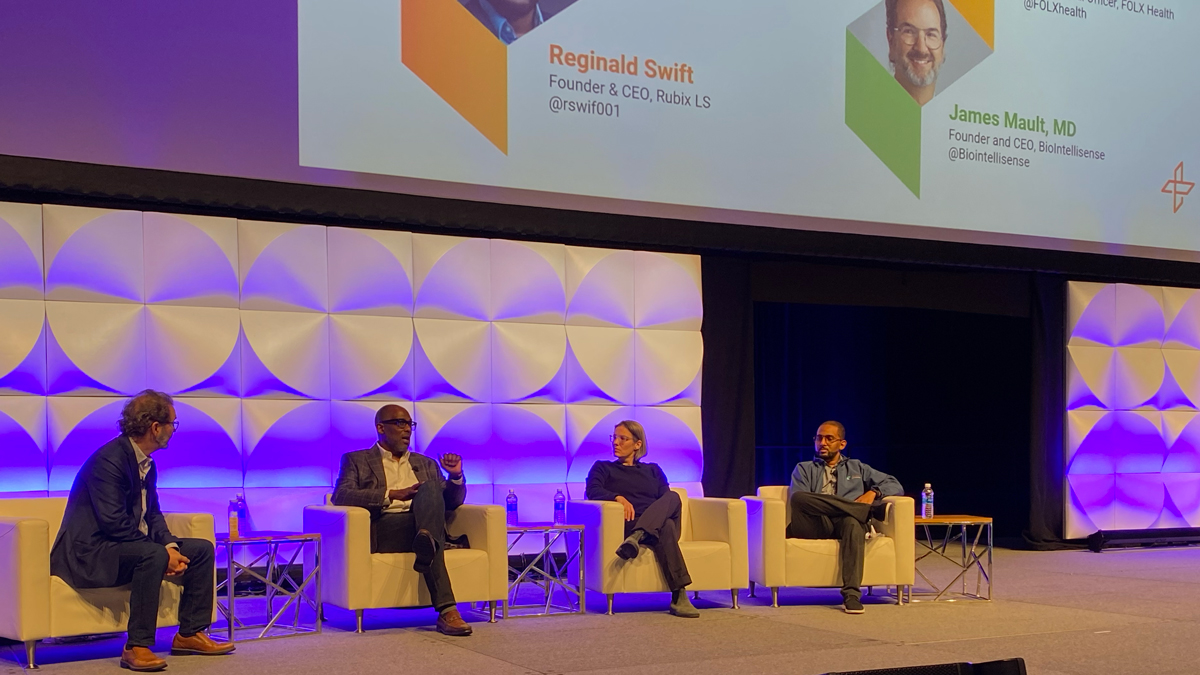To increase clinical trial diversity, build trust in communities and use tech wisely

After a long period of not much change, clinical trials are undergoing several massive shifts. At the American Telemedicine Association conference in Boston this week, a Sunday afternoon panel explored the intersection of two of these changes: the growing use of telehealth in decentralised clinical trials, and an increased awareness of the importance of health equity and diversity in trials.
Moderated by BioIntellisense CEO Dr. James Mault, the panel featured three activists and entrepreneurs who are working on clinical trial equity in underserved communities: Silas Buchanan, founder and CEO of the Institute for eHealth Equity; Kate Steinle, chief clinical officer at Folx Health, a startup dedicated to providing telehealth and other medical services to the LGBTQ community; and Reginald Swift, founder and CEO of Rubix Life Sciences, which uses data analytics to help pharmaceutical companies reach underserved communities.
Pros and cons of decentralised trials for marginalised communities
The relationship between decentralised trials and clinical trial diversity isn’t strictly complementary or contradictory, panellists said. Instead, the design of decentralised trials needs to be done with equity in mind. If that’s done well, the digital format can be an asset for health equity. But done badly it can be a hindrance.
“It's not an either or proposition,” Mault said. “We have to be careful swinging so much to leveraging technology and not realising that the community is in many ways the best way to recruit. We just have to be smarter about recruiting across more diverse, even local, communities.”
Positively, telehealth gives providers more control over the care experience, which makes it easier to build trust among underserved communities.
“When somebody goes into an in-person healthcare center, they're interacting with a security person, they're interacting with the person at the front desk, the medical assistant. There's so many different spots where that person could abruptly have a crappy experience and turn away entirely. And I think in telehealth, … we have that ability to continue to build that trust because we're not up against all of the external stuff. We've been able to build the models and the structure so that hopefully every single experience that someone has is going to be positive or at least it's not going to be really horrible.”
Additionally, digital experiences provide a lot of opportunities for data gathering, which can help providers understand those communities and serve them better.
Swift’s organisation is very focused on creating relationships with patients that allow them to collect data that they can then use to recruit diverse populations for their clients. They do this by creating opportunities for folks to find care in their communities, including using digital technology.
“Many of the patients that we talked to …, they're not going to have regular visits from PCPs, they're not going to have regular visits from hospitals or doctors. So they need to try to find information from any which way they can,” he said. “So we're offering that information freely. Right. And then it's information that we're sharing, which now they're sharing their name, they're sharing their income, they're sharing their information. It's all being gravitated towards us, not us forcing it on them. … So that is what has been the model of our success.”
On the negative side, of course, are access issues around broadband and technology that could make it hard for underserved populations to participate in decentralised trials. Buchanan mentioned the AT&T digital redlining scandal as an example of digital access inequities.
Additionally, Steinle said, organisers of decentralised trials need to make sure that just because they can now recruit participants from anywhere, that doesn’t mean they can ignore geography, which is an important social determinant of health, in recruiting a patient sample.
“This decentralised trial can have a wide swath,” she said. “But then are you going to lose some of the pieces in those particular neighbourhoods or that particular community? How does that all feed in?”
Ultimately the only solution is measurability and accountability.
“Now if we're saying we're still trying to target health equity, and we have decentralized trials, but we're still having less than 45% of equity within specific trials,” Swift said. “Well, guess what? The strategy didn't work, and now the tools actually didn't work as well. So we have to take a look at it from the top down approach on ensuring that we have to have a robust strategy on health equity from all types of environmental conditions.”
Meeting communities where they are
Health stakeholders have recently begun to understand the importance of reaching out to underserved communities during clinical trial recruitment. But understanding the importance is only a first step. Even more important is knowing how to reach out to these communities.
All three panellists discussed the importance of building community trust by working through members of the community or people who look like them.
“The messenger many times is more trusted than the message itself,” Buchanan said. “So we're looking to change messengers and partner with health care and industry folks so that the messengers are different and folks are a little more comfortable being engaged.”
Buchanan’s group, the Institute for eHealth Equity, is working with Morehouse School of Medicine to train health ministers – leaders of faith communities in underserved areas – who can help create a bridge of trust.
“If you're a relatively healthy person, but a faithful person that goes to church fairly regularly, you'll see your physician 20 minutes a year for your annual physical, but you'll spend 70 hours a year in church,” he said. “So where are we conducting decentralized trials and we can do them remotely in places that are more likely to be trusted by community members? I think that's key.”
Additionally, though, having researchers of colour leading the studies will go a long way. Buchanan’s group is working with Historically Black Colleges and Universities that have medical schools to encourage that participation. Similarly, Steinle has found that at Folx Health LGBTQ patients respond better to physicians who are themselves queer or who have deep-rooted experience working with queer communities.
Sharing data will garner trust
Above and beyond these tactics though, one very concrete thing that researchers can change is to take communities and community organisations seriously as partners.
“Typically you’ll find whoever has the NIH grant at the moment in the academic community is looking for participation in clinical research [from low-income communities]. And this is historically happened. And what are they offering in return? Right. Typically, it's a ham sandwich. We'll buy you lunch for your data, and we'll give you a ham sandwich. And so that drives this mistrust and continues to do so. And I would consider that maybe in the front hand of the slap and the back hand for me is that the data that flows from research, that community members and many times organisations are asked to help drive, none of that data is shared back with community-facing organisations that are embedded in underserved communities.”
Because community organizations are often much less well-funded than academic researchers, they aren’t able to get the same quality of data on their own. Sharing that data would help researchers to build strong, lasting, equitable relationships with communities.
“The data piece of this is so critical,” Buchanan said, “how we share data back with communities so that community members and organisations that are embedded in communities historically who are liked and trusted by community members actually own and control their own data and are able to leverage that data to drive more dollars for themselves.”




